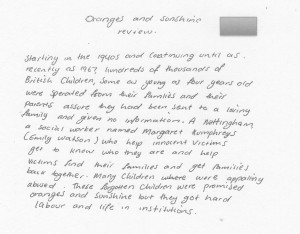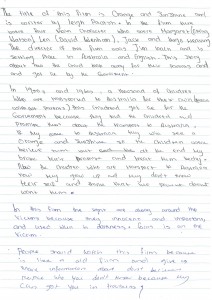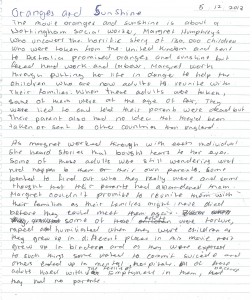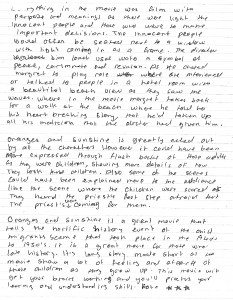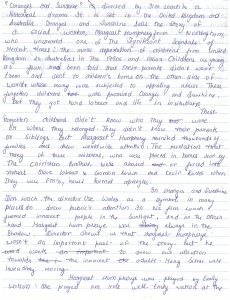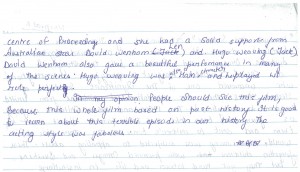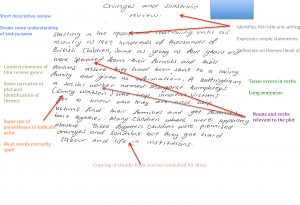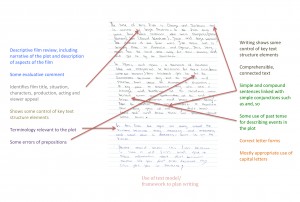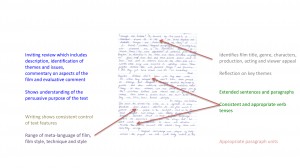20. A film review
Please click on the toggles below to navigate through information on this assessment task and reveal the links for downloading task materials.
Task details |
|
| Name of writing assessment task | A film review |
| EAL curriculum level range | B3, C2, C3, C4 |
| Text orientation | Persuasive |
| Task type | Extended response |
Task specification |
|
| Purpose | To assess student's ability to write a film review using persuasive language. |
| Description | Students view a film and then write a review. |
| Assumed knowledge and description |
|
Learning/teaching context |
|
| Language centre/mainstream class | Mainstream class – EAL support |
| Subject/key curriculum objectives, outcomes | English |
| Topic/teaching unit | Film reviews |
| Assessment conditions |
|
| Notes |
|
Task implementation |
|
| STAGE | ACTION STEPS |
| Pre-assessment activity |
|
| Assessment activity |
|
| Post-assessment activity |
|
TEAL Writing assessment criteria – Task 20 [PDF]
TEAL Writing assessment criteria – Task 20 [Word]
An explanation of the purpose, nature and use of criteria sheets is available at 4. Using the assessment criteria.
Purpose and nature of the task
This task is related to TEAL Oral Task 19: A book or film review, and TEAL Writing Task 19: A book review. The review of the film involves a text that has descriptive, narrative and evaluative elements. It also has a persuasive element to the extent that it may encourage readers to either see the movie or avoid it. In this task students are asked not only to provide a report on the plot and evaluative comment about the movie, the request for commentary on cinematic elements and how they are related to the themes and issues of the movie means this task is suited more to older EAL learners with relatively higher levels of proficiency. The text they are required to produce is consistent with movie reviews that may be encountered in the media (print, TV and online), and moving closer to mainstream classroom expectations from more controlled tasks asked of learners at earlier stages of their EAL learning.
Commentary
All of these samples were produced in the context of a Year 10 EAL/literacy class. The class viewed the film ‘Oranges and Sunshine’ (Icon Film distribution 2010), which describes the way an English social worker discovers the circumstances of supposed orphans who were sent to Australia as child migrants in the 1950s and 60s, even though their parents were alive and had no idea that the children were being sent overseas. The students viewed the film, and were given two authentic reviews of the movie. The class was given a list of movie terminology and expressions, which they related to parts of the movie. Exploration of the reviews provided a context to explore the genre, content and language of film reviews, as well as discussing the film at the levels of plot, themes, issues, acting roles, and the techniques used in movie production to create effects and meanings in the movie. The students were given the task sheet, which guided their writing of the review by identifying five paragraphs and the content to include in each one, with a final mark of signal of rating level.
The texts produced by the students are at different levels of performance of the task on the criteria sheet. All the texts produce comprehensible writing, but sample 1 is limited to description of the plot. The other samples are more successful in addressing the requested elements, although with different levels of control over the grammatical structures needed to do this. Samples 3 and 4 demonstrate greater control over a range of grammatical structures, though there are some errors and gaps in vocabulary. There are some sentences that occur in a number of the reviews, such as ‘These children were promised oranges and sunshine but they got hard labour and life in institutions’. Variants of this sentence and some others are found in many online reviews or descriptions of the movie, which suggests the students have looked for models and ideas beyond the model reviews given to them in class. In some cases the students have reproduced such sentences with very little variation of form, suggesting some of them prefer to use a model they see as authoritative, and lack confidence in using their own words and constructions to express their ideas. Some of the grammatical errors may also result from the students attempting to incorporate expressions they have seen in texts they have looked at into their own sentence structures.
Year: 10
Commentary
This is a short, rudimentary review, which demonstrates a good understanding of the movie plot, and some understanding of the nature of a film review. The review describes some key elements of the plot. It demonstrates some awareness of the genre of a film review, including providing a title, a statement of the setting, and the use of parentheses to indicate the actor who plays the main character. Ideas are communicated and appropriate vocabulary is used, but there are some errors of parts of speech, esuch as appalling for appallingly. A range of verb tenses are used, there are some tense errors, such as assure for assured. The writing is legible, and there is mostly accurate spelling, with some exceptions, for example, sperated for separated. The final sentence appears to be copied, as it matches a common summing up sentence that appears in slightly different forms on several web sites that summarise the film, such as http://www.charlbury.info/events/1779
The student has made limited use of the scaffolding provided in the task sheet to help write a complete review.
The marked criteria sheet shows that the student meets most criteria at level 1.
The student’s language use in this task is consistent with the descriptions of students at Level C2, Victorian Curriculum F-10 EAL.
Using this assessment to further learning
- Review the structure and expectations of a film review.
- Ask the student to review the task implementation sheet.
- Ask the student to identify which elements are included in their review.
- Ask then to write short paragraphs for the elements not written in the draft of the review.
- Using the right verb tense in a narrative.
- Point out that student has correctly used some tenses, by putting them in a relevant past tense, and some are incorrectly written, where they have not been converted to a past tense.
- Explain how in narratives, the verbs for the events in the narrative are usually put into the past tense. Some tenses may remain in present tense if they are part of a longer verb phase in which the main verb is in the past, or if they explain something that is generally true, and not specific to the time or sequence of events in the story.
- Ask the student to review the verbs by writing the it in the first column of the table
- Identify the tense used (present or past) and fill in the second column
- Identify where the tense used is correct or not. The first two verbs are given as examples of what to do:
| Verb | Present or past | ✓ or correction |
| were separated | past | ✓ |
| assure | present | assured |
- Using you own words to convey ideas from texts and resources consulted.
- Show the student a website such as http://www.charlbury.info/events/1779
- Ask them to compare their last sentence with an almost identical sentence on the website, and discuss the potential problems that may arise if it looks as if a student has directly copied form a source, rather than using their own words. Emphasise the value given to originality in academic contexts.
- Ask the student to look at the following table to summarise the ideas in the sentence, and identify alternative ways of expressing the ideas:
| Words for people and things | Words for main actions | Words for other information | |
| Original sentence |
forgotten children oranges and sunshine hard labour institutions |
promised got |
but |
| Alternative words or phrases |
neglected children a life of ‘oranges and sunshine’ hard work orphanages |
experienced assure |
instead |
| Original alternative sentence | Assurances of a life of ‘oranges and sunshine’ were made to these neglected children, instead they experienced hard work and life in unfriendly orphanages. | ||
You may need to show students how to use a thesaurus to find synonyms, and how changes of parts of speech, (such as nouns being changed to verbs of the same meaning) can help them to write original sentences.
- Ask the students to use the table format given here to convert at least two sentences from the model reviews they were given or another source they have found into their own original sentences.
| People and things | Main actions | Other information | |
| Original sentence | |||
| Alternative words or phrases | |||
| Original alternative sentence | |||
Year 10
Home language: Karen
Commentary
The review follows the structure requested and includes all the requested elements. The paragraph commenting on cinematic elements of the film is not as strong as the narration of the plot or the recommendation about the film. Sentence level grammar errors and some vocabulary errors are noticeable, and while the intended meanings are generally clear, these problems detract from the credibility of the writing. The student has mistaken the author of one of the modelled reviews, Leigh Paatsch, for the writer of the film. There is a high frequency of errors with linguistic structures and grammar. These include errors and clumsiness in sentence structures where expression of complex ideas is attempted, such as in paragraph two ‘the children got lie for the government’ (meaning ‘the children were lied to by the government’). There are problems with verb tenses used (the use of simple past to talk about the film in the first paragraph, then the use of simple present to describe the plot in the second). There are errors in some verb forms, including an error of subject-verb agreement ‘the light are always around the victims..’, problems with errors in auxiliary verb choice, the children got lie to for the children were lied to. These often relate to difficulties in using passive verbs. Correct verb forms are used, (such as ‘they broke their promise) although some times in the wrong context, as in the parent doesn’t want him (for the parents didn’t want him’ . Some vocabulary errors are made e.g. the setting place (for ‘the setting’) and English (for England). There are some words written correctly at one place an incorrectly at another children/childred, some use of inappropriate pronouns, such as they broke their promise and treat him badly’ (instead of them,) theirself, for themselves. Despite these errors, the review conveys a strong understanding of the film, and suggests the student doesn’t yet have adequate control over English structures to always adequately convey the extent of their understanding and ideas. The concluding sentence is an interesting, perhaps culturally-influenced, perception of the student about the moral of the film – not trusting people you don’t know.
The marked criteria sheet shows that the student meets most criteria at level 2 of performance of the task.
The student’s language use in this task is consistent with the descriptions of students at early Level C3, Victorian Curriculum F-10 EAL.
Using this assessment for further learning
- Missing subjects and verbs
- Point out to the student there are some problems of missing subjects and verbs in paragraph 1.
Ask the student to insert the missing subject or verb in the sentences below:
| The title of this film is ‘Oranges and Sunshine’, and ____ is written by Margaret Humphreys. |
| The director of this film was Jim Loach and ___ is set in Australia and England. |
| This story ____ about how children were taken away from their parents and lied to by the government. |
- Passive verb forms
- point out to the student that there are some places where the writer tries to describe something happened to someone.
- show how a passive verb form can be used to express this type of meaning. You could use examples from the film.
- Ask the student to complete the table by using a passive rather than active verb
| Text | Intended meaning – active | Intended meaning- passive |
| Is writer by Leigh Paatsch | Leigh Paatsch wrote.. | ..is written by Leigh Paatsch |
| The child took away for their parents | The government took the children away from their parents | |
| got lie by the government | The government told lies to the children | |
| children were transport to Australia | ||
| children were transport to Australia | ||
| They broke their promises | Promises… |
- Not quite, but nearly, the right word or words
In the text the meaning of some words or phrases is clear, but the expression is not quite right!
Use the list given to identify expressions that are not quite right, and then write the correct form for each expression in the table.
on their own the setting English thousands of children themselves oranges always
| Text | Correct word | Correct word in sentence |
| Is setting place | The setting | The setting is.. |
| is English | England | The setting is Australia and England. |
| For their own | ||
| Their self | ||
| A thousand of children | ||
| They will see a orange and sunshine | ||
| The light are always around the victims |
Year 10
Home language: Dinka
Commentary
This sample is a fluent review that provides the elements suggested by the task sheet. The writing is quite comprehensible, although some errors are evident. The content of the ideas is quite sophisticated. There is tendency for sentences to be rather long, and in some places the boundaries between sentences are not clear. The student uses longer sentences successfully most of the time to connect ideas and event. There is quite good control of tenses and verb forms, use of simple past to recount the plot and simple present to describe the film. There is a range of descriptive language in the text, achieved through the use of a wide range of verbs and the use of adjectives such as in ‘horrific story’. There are some spelling errors, such as ‘emtyness’, and some misplaced capital letters. ‘Margret’ is misspelt, and there is some clumsy expression such as ‘Oranges and sunshine is greatly acted out…’. The intended meaning of one word in the second last sentence of the second paragraph is not clear, ‘most of the children grew up in birdoo(?)’ However these quite numerous, but relatively minor errors don’t interfere with the reader’s ability to understand what is being said, and don’t detract significantly from the credibility of the text.
The marked criteria sheet shows that the student meets most criteria at level 3 of performance of the task, with some at level 4.
The student’s language use in this task is consistent with the descriptions of students at Level C4, Victorian Curriculum F-10 EAL.
Using this assessment for further learning
- ‘Clumsy’ expression
- Explain to the student that there are some sentences in the text that while being comprehensible, are not expressed in the way they usually would be in English.
- Match such sentences from the text, in the left column of the table below, with a more usual expression of the idea in the right column. Draw a line to show which sentences match.
| Sentence from the text | Model sentence |
| 1. ‘Oranges and Sunshine’ is greatly acted out by all characters. | Some of the adults in the film were children of the age of four when they were taken to Australia. |
| 2. When these adults were taken, some of them were at the age of four. | ‘Oranges and Sunshine’ is a great movie that tells horrific stories of the child migrant scheme of the 1940s and 1950s. |
| 3. Everything in the movie was filmed with purpose and meanings as there were light on the innocent people and those who were to make important decision. | In ‘Oranges and Sunshine’, the acting is very well done. |
| 4. ‘Oranges and Sunshine’ is a great movie that tells the horrific history events of the child migrant scheme that took place in the 1940s to 1950s. | The symbolism of the film is strong, with effects like constantly seeing innocent people and those who make important decisions in full light. |
Ask the student to carefully check the differences between the sentences and their matching model sentence, and underline the corresponding, but different phrases in the two sentences. You could suggest they use the model sentences to substitute for the original sentence next time they revise or rewrite the text. Point out that the model sentences are usually shorter.
- Overly long sentences
- Discuss with the student the advantages and disadvantages of long and short sentences in a text like this.
- Ask the student to rewrite each of the following sentences form the text in a series of shorter sentences:
(a) Some of those adults were tortured, raped, humiliated when they were children as they grew up in different places different places most of them grew up in ?? and as they were exposed to such things some wanted to commit suicide and others ended up in mental hospitals.
(b) Also, some of the scenes could have been explained more to the audience like the scene where the children were scared as the heard to priests’ footsteps afraid that the priests were coming for them.
- Passive verbs
- point out where the student has successfully used passive verbs., such as: were taken, were lied to, some of these adults were…raped, often be seated.
- ask the student to check the text, and look for places were there are errors in the sue of passives, and correct them.
Year: 10
Home language: Punjabi
Commentary
This sample is a successful completion of the task, and successfully follows the structure the students were given as a guide in completing the task. The film is named, along with details of director in paragraph 1, and the basic outline of the story is provided. In the following paragraphs information is given about the plot and themes, issues are identified. The third paragraph moves to describe cinematic devices used in the film, while the fourth comments on the ways the actors play their roles. The review concludes with a statement as to why people should see the film.
The writing is clear and competent, though some characteristics of EAL student writing are evident. There are a few long and clumsy sentences, some minor grammatical errors, and some errors of punctuation. Some of these are consistent through the text, such as addition of ‘s’ to the end of children, formation of the letter ‘s’ at the beginning of words that looks as if it is capitalized, which is not evident when ‘s’ is in the middle of a word, and consistent misspelling of Margaret Humphreys’ surname. A common sentence used in website descriptions of the movie, referred to in the annotation of sample 1, also appears in this text. The sentence about apologies from British and Australian Prime Ministers is not well connected to the rest of the text.
The marked criteria sheet shows that the student meets most criteria at level 4.
The student’s language use in this task is consistent with the descriptions of students at Level C4, Victorian Curriculum F-10 EAL.
Using this assessment for further learning
- Checking the originality of your work.
- Remind the student of the emphasis given to originality in academic work.
- Point out the sentence that appears in many websites about the movie. Ask the student to revise the sentence to make it original. If necessary use activity 3 in the annotation on sample 1 of this task.
- Proof reading check list
- Ask the student to look at this list of common errors made in student writing. Ask them to check their draft to make sure they haven’t made any of these mistakes:
| Area | Explanation and comments |
|
1. Punctuation
2. Capitalisation
3. Spelling
4. Grammar
5. Correct tenses
6. Sentence formation
7. Connections within the text
|
Full stops, commas, exclamation marks, inverted commas etc. Are apostrophes misplaced? E.g. used with plurals? Capital letters for the start of sentences, country and place names, people’s names, but not for important words or expressions just because they are important!
Place names and people’s names can be a common source of errors. Some ways of writing letters can make them look like capital letters when they shouldn’t be!
Are the correct forms of words (nouns, verb, adjectives, adverb etc used? Are the right plurals used? Are sentences properly formed? Do the subjects and their verbs agree?
Are the right verb tenses used? Are the right forms of all verbs used?
Are all sentences well-formed, with a clear subject and verb? Is other information presented in sentences provided in grammatically correct structures?
Are all sentences clearly connected with other parts of the text, so the reader can easily follow what is being and said and why it is mentioned? |

